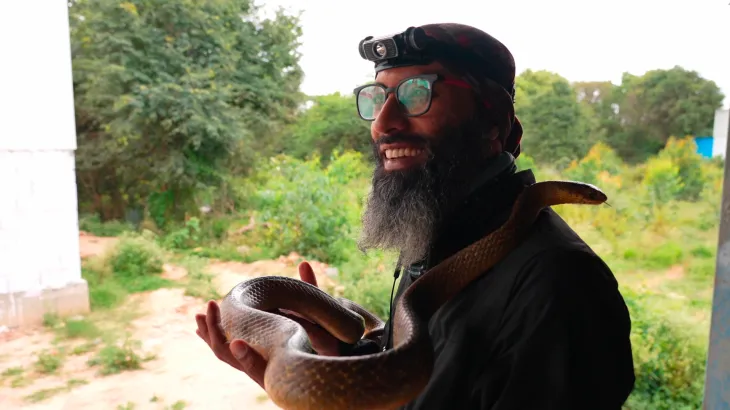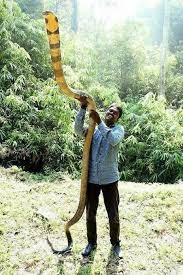🐍 Can Humans and Snakes Coexist in a Megacity?

The concrete jungles of India’s megacities are rapidly expanding, consequently pushing human habitations deep into natural wildlife corridors. Therefore, encounters between residents and snakes—including the highly venomous “Big Four” species—have become alarmingly common. This situation creates a critical conflict. On one side stands innate human fear, superstition, and the tragic reality of snakebite mortality. On the other side stands a dedicated, often unsung group of volunteers: India’s snake rescuers. These individuals risk their lives daily to relocate these misunderstood creatures. Their work clearly demonstrates that coexistence between humans and serpents is possible, but only through specialized knowledge, unwavering dedication, and widespread public education.
The Ecology of Conflict: Why Snakes Enter Our Homes Snakes
Indian megacities like Mumbai, Delhi, Bengaluru, and Kolkata are hotspots for snake-human conflict. The reason is twofold: ecology and climate.
- Habitat Loss is Key: First and foremost, unplanned rapid urbanization has caused natural habitats to shrink dramatically. As a result, wetlands, forests, and grassy plots are replaced by cement and tar. This encroachment traps snakes within isolated green pockets. Consequently, they are forced to venture into human settlements in search of food, water, or mates.
- The Rainy Season Surge: In addition, snake sightings surge dramatically during the monsoon season. This increase occurs because heavy rains flood snake burrows and constricted drains. Therefore, displaced snakes seek dry, safe shelter inside homes, schools, and offices. This is why rescuers often receive numerous calls at night during the rains.
- Following the Prey: Furthermore, snakes are essential pest controllers. They follow rats and rodents, which are often abundant beneath concrete slabs and poor sanitation areas in urban dwellings. Thus, the presence of rats directly attracts snakes like the Spectacled Cobra and the Indian Rat Snake, thereby bringing the reptiles into close contact with humans.

The Serpents Among Us: The Urban Species Snakes
Indian cities host a surprisingly rich diversity of snake species. For instance, Delhi alone has recorded at least $23$ species. However, the four most medically significant snakes, known as the “Big Four,” are responsible for the vast majority of snakebites. They are:
| Species | Danger Level | Urban Presence |
| Spectacled Cobra (Naja naja) | Highly Venomous | Common, often found in homes and gardens. |
| Russell’s Viper (Daboia russelii) | Highly Venomous | Found in scrublands, fields, and urban fringes. |
| Common Krait (Bungarus caeruleus) | Highly Venomous | Nocturnal, often encountered inside homes at night. |
| Saw-scaled Viper (Echis carinatus) | Highly Venomous | Small, but widespread; often found in dry, rocky areas and busy streets. |
In contrast, the most frequently rescued snake in cities like Delhi and Bengaluru is the non-venomous Indian Rat Snake (Ptyas mucosa). Despite being harmless, the Rat Snake is often mistaken for a cobra, consequently leading to panic and unnecessary harm. Therefore, snake identification training is a key part of the rescue effort.
The Unsung Heroes: Life of a Snake Rescuer
The people who respond to these panic calls are the backbone of human-serpent coexistence. These snake rescuers are mostly volunteers, often coming from backgrounds like farming, security, or even engineering. Their dedication stems from a deep love for snakes and a commitment to conservation. However, their vital role often goes unsupported.
- High Risk, Low Pay: Crucially, snake rescuing is an extremely high-risk job. Rescuers face potentially fatal implications if bitten. Yet, many rescuers, particularly those working with municipal bodies like the BBMP in Bengaluru, receive paltry pay or infrequent stipends. In some cases, they are not compensated for their transportation costs.
- Lack of Formal Support: Furthermore, many rescuers operate without formal training, standard safety equipment, or medical insurance. A study of rescuers in Tamil Nadu highlighted the urgent need for appropriate regulation by the State Forest Departments. This regulation should include formal training, necessary equipment, and medical coverage. Therefore, the current system relies heavily on the altruism and personal financial sacrifice of these individuals.
- More Than Just Catching: The rescue itself often takes only a few minutes, but the educational component is considered just as important. Rescuers spend time teaching households about snake behavior, proper first aid measures, and the ecological importance of snakes. This essential work aims to replace fear with respect and rational action.

The Path to Coexistence: A Multilayered Solution Snakes
Achieving harmonious human-serpent coexistence in dense megacities requires a multi-pronged strategy involving government, community, and conservationists.
1. Improving Public Awareness and Response
Firstly, public education is the most powerful tool. Programs should focus on teaching citizens to distinguish between venomous and non-venomous species. They must also emphasize the critical importance of remaining calm when a snake is sighted. Consequently, the priority should always be calling a trained professional immediately. Furthermore, communities need to be aware of the “Big Four” and understand the signs of a bite, encouraging immediate hospital care rather than relying on traditional healers.
2. Professionalizing the Rescue Network
Secondly, authorities must professionalize and support the snake rescue network. This includes recruiting more trained professionals, as some cities are severely understaffed. It also means providing fair wages, medical insurance, and mandatory professional training to minimize the risk of snakebites among rescuers. Finally, regulated protocols for safe release, such as documented relocation to suitable reserve forests, must be strictly enforced.
3. Smart Urban Planning
Thirdly, future urban development must consider wildlife corridors. Better garbage disposal practices and the proper upkeep of stormwater drains would reduce rodent populations, thereby naturally reducing snake encounters. Furthermore, creating wildlife buffers for the movement of urban wildlife is crucial for maintaining ecosystem balance within the city. The lack of proper development often exacerbates the conflict.
A Future of Shared Space Snakes
India accounts for nearly half of the world’s snakebite deaths, a staggering figure that underscores the intensity of this human-wildlife conflict. However, the quiet courage and dedication of the nation’s snake rescuers offer a powerful antidote to fear. Their ability to safely relocate thousands of snakes annually proves that humans and serpents can indeed share space, provided that caution is met with compassion and knowledge. Therefore, the future of coexistence rests on society valuing the life-saving, ecosystem-protecting work of these unsung heroes, consequently allowing the ancient serpent to maintain its vital role in the megacity’s ecosystem. Snakes
Read More Articles Click Here. Read Previous Article Click Here.



